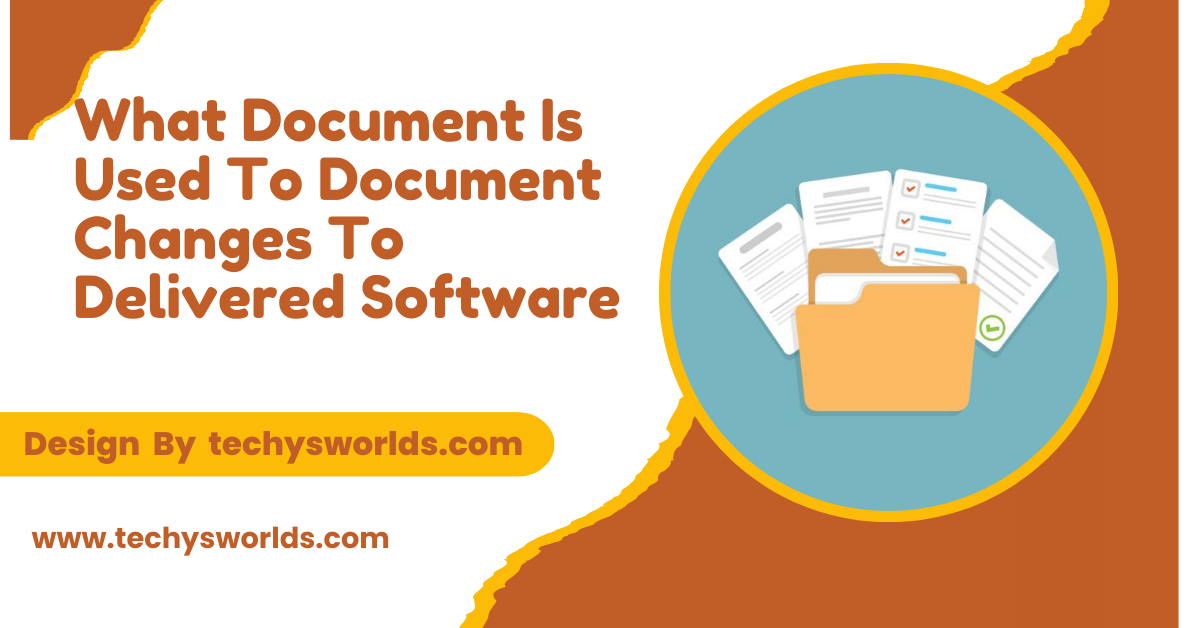Change Logs, Release Notes, and Patch Notes track changes to delivered software, outlining updates, fixes, and new features.
In this article, we will discuss “What Document Is Used To Document Changes To Delivered Software”
The Importance of Documenting Software Changes:

Documenting changes to software is essential for several reasons. It helps teams track updates, provides transparency for users, ensures accountability, and supports bug tracking. Documentation also aids compliance in industries with regulatory requirements. Well-documented changes keep all stakeholders on the same page and improve the overall software development process.
Types of Documents Used to Document Software Changes:
Change Log:
A Change Log is a simple document that lists all the changes made to the software over time. It’s typically organized by version numbers and includes a brief description of the changes, bug fixes, or updates. Change Logs are especially useful for developers and internal teams.
Also Read: Entertainment Software Association – A deep dive!
Key Elements of a Change Log:
- Version Number: Identifies the update version.
- Date of Release: Specifies the release date.
- Description of Changes: Briefly explains the update.
- Bug Fixes: Details resolved issues.
- New Features: Summarizes new functionalities.
Release Notes:
Release Notes are detailed documents that explain what’s included in a particular software release. These notes are often intended for end-users and developers, providing a more thorough explanation of updates, new features, bug fixes, and any known issues.
Key Elements of Release Notes:
- Overview: A high-level summary of the release.
- New Features and Enhancements: Highlights the additions and improvements.
- Bug Fixes: Lists the issues addressed in the update.
- Known Issues: Describes ongoing problems.
- Installation and Upgrade Instructions: Provides guidance on how to install or upgrade.
Patch Notes:
Patch Notes focus on small updates or fixes, often addressing specific bugs, security vulnerabilities, or performance issues. These notes are concise and usually focused on specific patches rather than larger updates.
Key Elements of Patch Notes:
- Bug Fixes: Specifies the bugs addressed in the patch.
- Security Updates: Patches that resolve vulnerabilities.
- Performance Improvements: Enhancements made to the software’s performance.
Change Request Documents:
Change Request Documents (CRDs) are formal proposals for changes to the software. These documents are typically used in more complex software environments, where changes require approval from stakeholders before they are implemented.
Key Elements of Change Request Documents:
- Description of the Change: Explains what change is needed and why.
- Impact Assessment: Evaluates the effects of the change on the software.
- Approval Process: Details the necessary steps for approval.
- Testing Requirements: Specifies the testing needed after the change.
- Implementation Timeline: Provides a schedule for the change to be completed.
Best Practices for Documenting Software Changes:

Keep It Clear and Simple:
Documentation should be written in simple, clear language to ensure it’s accessible to both technical and non-technical users. Avoid jargon wherever possible and explain any technical terms when needed. Clear documentation helps users understand what’s new and how it affects them.
Be Consistent in Format:
To make changes easier to track, use a consistent format for all updates. Include version numbers, release dates, and clear descriptions. Keeping your documentation format uniform helps users and developers find important information quickly.
Organize Information Effectively:
Group changes into categories such as new features, bug fixes, and performance enhancements. This organization ensures that readers can easily identify relevant changes based on their interests or needs. Consider putting the most important updates first to grab attention.
Keep It Updated Regularly:
Documentation should be updated each time an update or patch is released. Regular updates ensure that users and stakeholders have the most current information, preventing confusion and promoting transparency.
Track Backward Compatibility:
It’s essential to note whether a new update is backward-compatible. If a new update breaks compatibility with previous versions, users should be informed in the documentation. This helps prevent issues when users upgrade their software.
FAQ’s
1. What document is used to track changes to delivered software?
The most common documents used for tracking changes are Change Logs, Release Notes, and Patch Notes.
2. How detailed should change documentation be?
Change documentation should vary in detail based on the audience. Release Notes are more detailed and user-focused, while Change Logs are simpler and more technical.
3. What is the difference between Release Notes and Change Logs?
Release Notes are more detailed and explain the changes in the release, while Change Logs provide a concise list of changes for developers and technical teams.
4. What are Patch Notes used for?
Patch Notes are used to explain minor updates, such as bug fixes or security patches, typically addressing specific issues or vulnerabilities.
5. Why are Change Request Documents important?
Change Request Documents are important for proposing and approving significant changes, especially in regulated environments, and ensuring that all necessary stakeholders are involved in the decision-making process.
Conclusion
Documenting software changes is a vital part of the development process. Whether it’s a Change Log, Release Notes, Patch Notes, or Change Request Documents, proper documentation ensures transparency, accountability, and effective communication. By adopting best practices, software teams can streamline updates and keep all stakeholders well-informed.
Related Posts
Also Read: Logitech Mouse Software – Features, Benefits, and Customization!
Also Read: How Many Company Offer Software Defined Access – Key Players and Offerings!
Also Read: List Of Amazon Softwares – Enhancing Business Operations!



